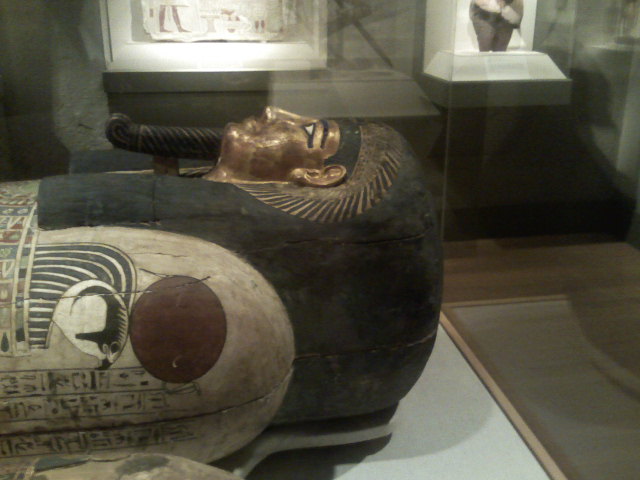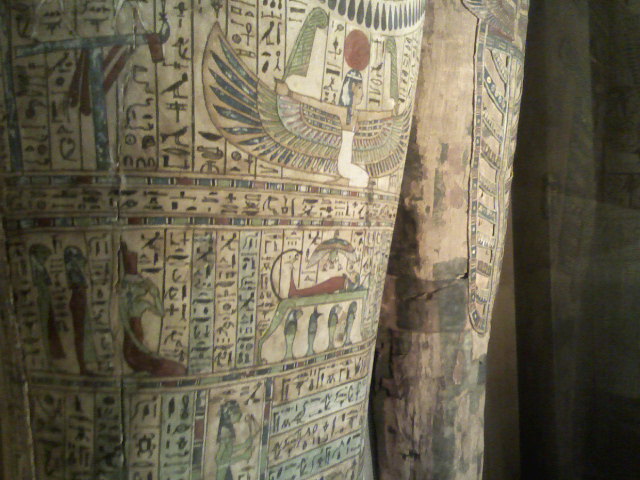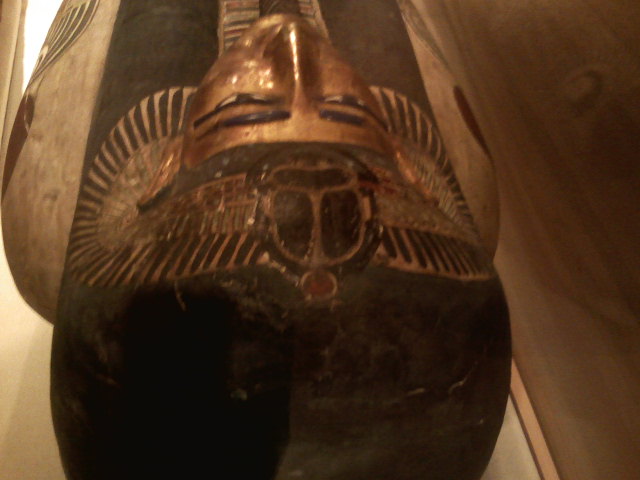ART IN ANTIQUITY: The Coffin of Nesmin
The coffin of the Egyptian priest Nesmin immediately captivates the viewer with its brilliant colors, intricate details, and rich symbolism. The smooth surface of wood and gesso is covered by hieroglyphs, designs, and depictions of ancient gods and goddesses. Found from the Ptolemaic period in Thebes, Egypt, this sarcophagus dates from somewhere between 305-30 BC. This period of Egyptian history followed Alexander the Great’s conquest of Egypt in 332 BC, and was influenced by Greek culture. This artifact, however, seems to show the survival of Egyptian traditions and culture despite the Greek presence.
The way in which the human figures are depicted on the surface of the coffin is consistent with other human representations of ancient Egypt. The lack of perspective and dimension of the figures is similar to those seen from earlier dynasties. Even the way in which the figures are posed, viewed from the side, is the same as how human forms were often shown in pieces typical of ancient Egyptians. Interestingly, the skin color of the figures is inconsistent. Some of the figures have green skin, some have a reddish brown, and others have a light tan color. Several of the figures seem to carry offerings. There are three of these figures one above the other on each side. The groups of three face one another across lines of hieroglyphs. The clothing worn by the figures, even the gods, is not very elaborate. They all seem to wear some sort of solid colored cloth, indistinguishable from the body except for the change in color.
Despite its age, the brilliant colors and designs on the surface of the coffin are preserved. Blue, green, red, black, and white punctuate the soft off-white color of the sarcophagus. These colors must have been meticulously mixed and created from different pigments and materials. The creation of these colors may have required trade and practice in mixing the materials to create the desired final color. The use of color makes the designs and painted figures ‘pop’ from the rest of the piece. In addition to the colors on the body of the coffin, the brilliant gold used for the face of Nesmin impresses not only the richness of the country, but that of the priest and his family. The high status of Nesmin as a priest is apparent through this use of the gilding. The designs with gold around the face demonstrate the craftsmanship of those who made the coffin. The headdress worn by Nesmin, framing his face is yet another indication of the riches or power of the priest. His eyes painted, as they would be in life, with kohl extending beyond the edges of the eye, add to the majestic look of the sarcophagus. The long goatee and intricate designs of a seeming necklace augment the viewer’s understanding of Nesmin as an important figure as well as the awe at the workmanship this piece of art must have required.
The complexity of the coffin is an indication of the importance of priests in Egyptian society. Only pharaohs and other people of high importance or great riches in society were given such elaborate burial rituals. The care and mummification of the body was a complicated and time-consuming process not done for most inhabitants. Hieroglyphics cover the sarcophagus and surround the designs. The writing is in both horizontal and vertical registers, some colored blue or yellow. Nesmin’s genealogy is written out on the chest of coffin, which may indicate that he came from a prominent family since his ancestors were known enough to create such a written record. Nesmin was a priest of Min, the god of fertility, and Khonsu, the moon god and god of healing. Both of these gods were essential to Egyptian life as the god of fertility was said to give the pharaohs the ability to bear a male heir, and the moon god played an essential role in the cycles of the sky. The importance of these two gods may help to explain Nesmin’s high status.
The actual mummification process is shown mid-chest on the coffin. The mummy lies on a table with a lion head and tail. Underneath the table, there are the canopic jars. All four jars are present with human-headed Imsety, guardian of the liver, falcon headed Qebeh-Seneuf guarding the intestines, Hapi, the guardian of the lungs with a baboon head, and finaly, Duamutef with the head of a jackal, guarding the stomach. Above the mummy, there is a bird with its wings spread, which could be Nekhbet, the guardian of Upper Egypt. Horus, the sky god, Anubis, god of mummification, Nephthys, guardian of the dead, and Isis, the protective goddess, are all easily discernable on the coffin standing on either side of the mummification scene.
The figures and chosen for the coffin each hold an importance to the afterlife or tribute to the life of the priest which indicates the planning that must have gone into the painting of the coffin. A scarab beetle rests at the head of the coffin, representing the sun and creation. At each shoulder, there is the head of a falcon with a red disk resting atop its head. This is presumably the god Khonsu whom Nesmin devoted much of his life to. The god min’s symbol, which looks like a double ended arrow, is held by the standing figures who face each other across lines of hieroglyphs towards the foot of the coffin.
The eye of Horus appears on both sides of the sarcophagus, and represents protection and healing, both of which tie into the afterlife. On one side, the eye of Horus is even on what seems to be a pedestal. The goddess Ma’at kneels at the center of the coffin, directly below the head with her wings spread. Her presence is essential to the priest’s journey into the afterlife as she is the goddess of order, harmony, justice, and balance. She was thought to be the one balancing the scale that weighed the heart of the dead, determining if passage into the afterlife would be allowed. On the tops of the feet of the coffin, two jackals lie facing one another atop tables. The jackal was associated with mummification and the newly dead and leading into the afterlife.
At the sides of the feet of the sarcophagus, a lion sits which often stood as guardians. At the bottom of the feet, a bull is depicted carrying a mummy. The bull is most likely the god Apis. Apis was an immensely important and sacred animal to the ancient Egyptians, and the fact that he is carrying the mummy once again underlines the high regard held for Nesmin. Another sacred animal, the ram, stands on a pedestal, wearing some form of a headdress, on both sides of the coffin.
This stunning piece is not only a vessel the in which Nesmin was carried into the afterlife, but endures as an impressive and majestic representation of Ancient Egyptian culture and ritual. By observing this ancient piece, a window into the past is created with both written and visual depictions of religious life and funerary practices. The time period in which the coffin was found also impresses upon the viewer the enduring culture of the Egyptians despite conquest and outside influence. This sense of continuity, however, only applies to a short time period, and this coffin survives as a testament to the brilliant craftsmanship, design, and customs of the ancient Egyptians.




BIBLIOGRAPHY
"Gods and Goddesses." Trustees of the British Museum 1999 28 Sep 2008 <http://www.ancientegypt.co.uk/gods/explore/main.html>.
Dunn, Jimmy. "Tour Egypt!." InterCity Oz 28 Sep 2008 <http://www.touregypt.net/>.
"Ancient Egyptian Symbols." Antigravitytechnology 2001 28 Sep 2008 <http://www.ancient-symbols.com/>.
"Egyptology Online." Astra Corporation Limited 2001-2008 28 Sep 2008 <http://www.egyptologyonline.com/>.
Wikimedia 28 Sep 2008 <http://www.wikipedia.org>.
